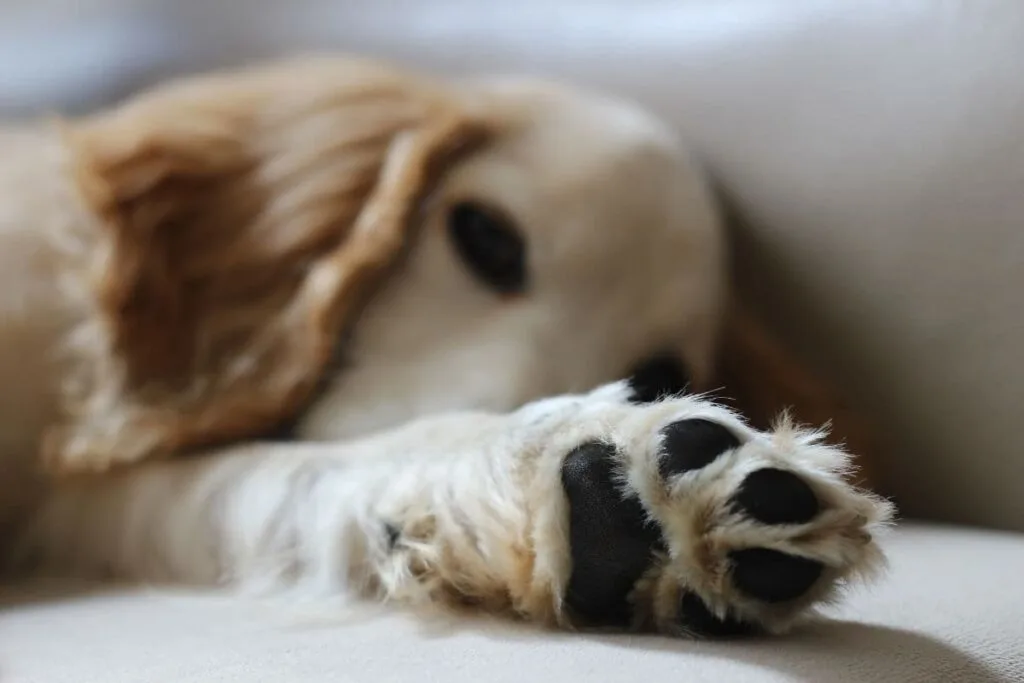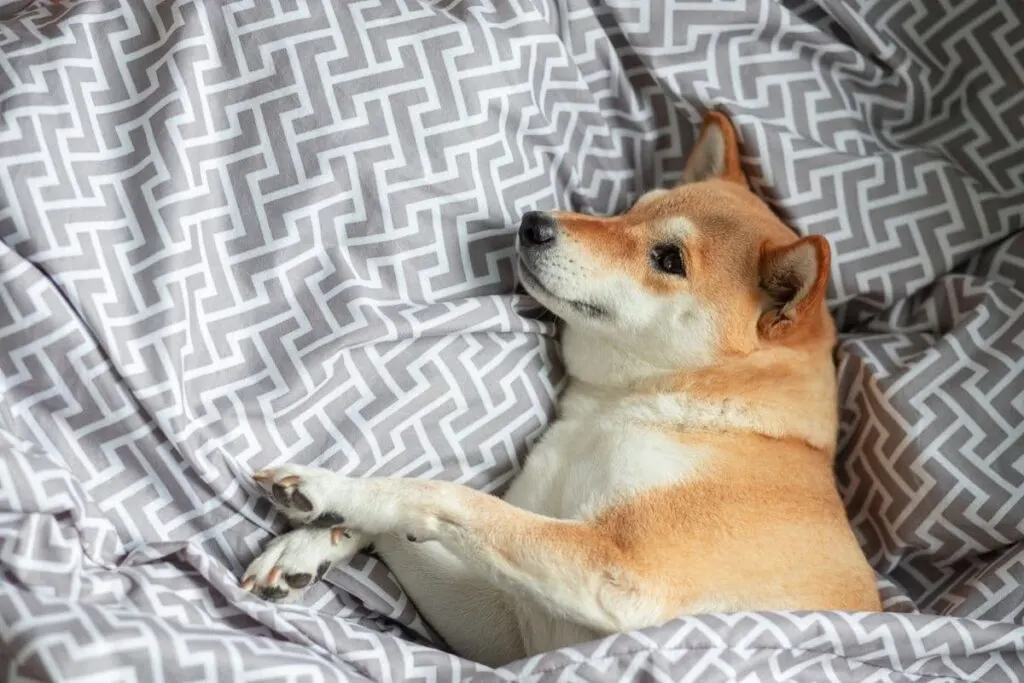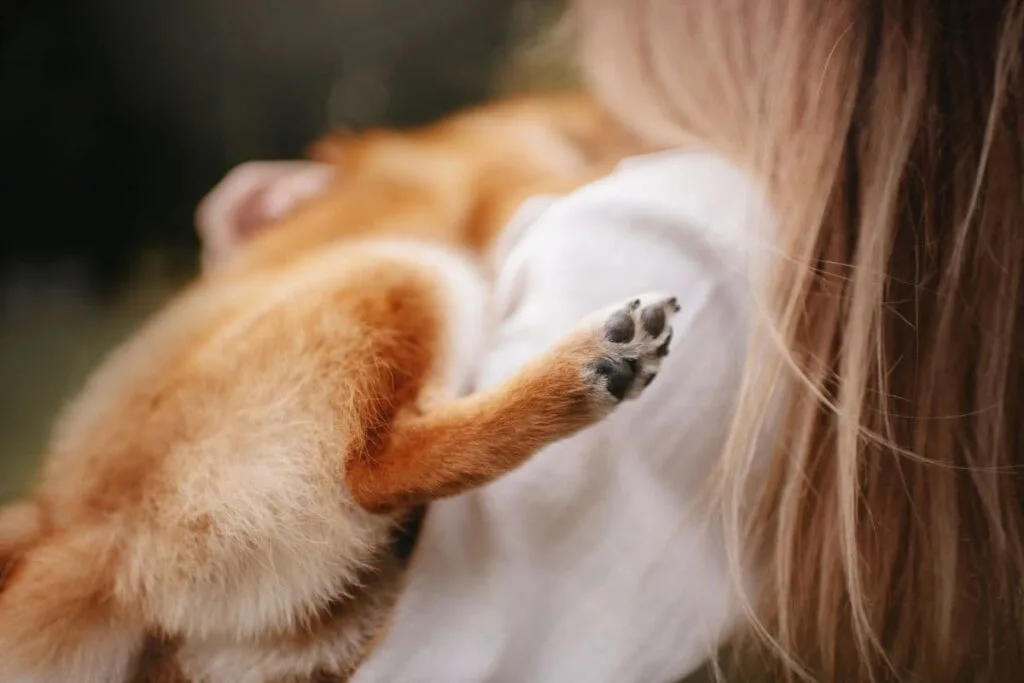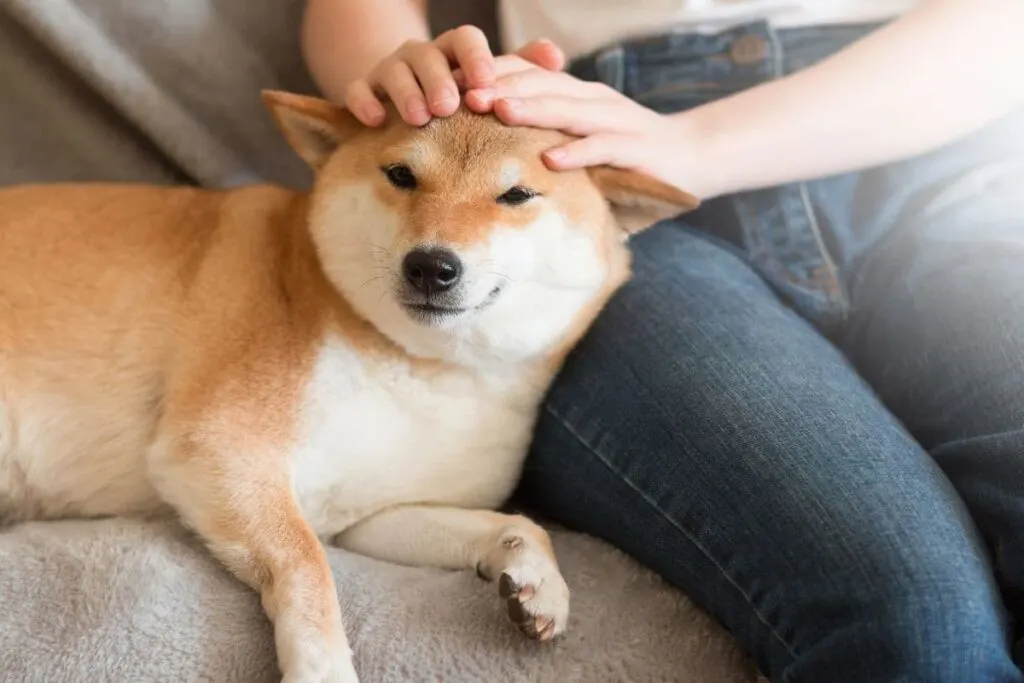Normally, when you pet a dog, they stay still as you stroke its fur. Yet, sometimes, they quickly begin to stretch out their bodies and flex their paws.
Dogs may flex their paws when you pet them for various reasons, including showing you a sign of their affection, it’s a natural reflex, and because they are relaxed.
In this article, I’ll cover why a dog may flex their paws while you pet them and what that reaction means, depending on the scenario.

Click Here to Jump to a Section
Do Dogs Express Affection by Flexing Paws?
Dogs express affection by flexing their paws because it’s a way to show that they are enjoying your loving scratches and prompt you to continue doing it.
When you pet your dog, it is a way for you to show them that you care for them and greatly appreciate them as a companion.
To reciprocate this affection back to the humans providing the petting, dogs will then make themselves comfortable in multiple ways, including stretching their paws and flexing them.
Flexing paws is a sign that not only does the dog being petted, but they’re also comfortable enough to let themselves be relaxed around you.
They could decide just to sit still and accept the pets or even walk away, yet flexing their paws demonstrates that they enjoy being petted.
When being petted, dogs are often naturally relaxed and feel safe enough to get more vulnerable by showing their paws, which is a sign of high and established trust between the dog and the human.
As I’ve mentioned, dogs show affection by flexing their paws, signaling to the human petting them that they are doing a great job and should continue doing it.
Dogs only do this if they like the person or people petting them; if they do not like them, there would be hesitation or, in some cases, aggression.
Their paws flexing outward or fanning out is a way for them to ask you to keep petting or to pet other areas of their body too.
Dogs Flexing Their Paws Show They’re Relaxed Due to a Lack of Stress Hormones
In addition to affection, dogs also flex their paws when you pet them because they are in a naturally relaxed state that removes any stress they may be experiencing.
Whenever you pet your dog, whether it’s to praise them for performing a trick or just because you want to show them a little bit of love, you’re making them feel happy and less stressed.
Any time that this sense of joy happens, it results in the release of a particular hormone known as oxytocin.
Oxytocin is found in all kinds of mammals, not just dogs.
It’s essential for helping certain bodily functions like blood pressure and mood expression stay regular.
The release of oxytocin happens when any kind of physical affection occurs, and in humans, this happens through actions like hugging, hand-holding, or kissing.
The more that a dog is pet, the more oxytocin hormones are released; when more oxytocin hormones are released, other stress-based hormones like cortisol are significantly reduced.
One interesting study conducted back in 2014 monitored the stress and cortisol levels of dogs who participated with humans in animal-based therapy environments.

During the entire duration of this observational study, dogs and humans were paired up for small amounts of time dedicated to petting.
All the people who agreed to be in the study pet, played with, and walked with the dogs.
While doing these exercises, they were watched and recorded before spit samples were taken from each dog to determine whether or not the dogs were happy or stressed out.
In addition to recording the levels of cortisol, observers also monitored the behavioral patterns of the participating dogs.
After conducting the study activity, it was determined that cortisol and stress levels remained stable or did not increase after being petted.
The findings show that petting is excellent for dogs because it helps release relaxing hormones, not negative stress-based ones.
As for the behavioral observation, many of the dogs stretched their legs outward and spread out their toes when they were given affection through petting.
This finding helps to identify that the flexing of toes and legs is directly related to a dog’s ability to feel relaxed in an enjoyable setting when petted.
The more oxytocin present and euphoric a dog feels, the more relaxed they will be.
With more relaxation comes a dog’s potential to spread out and flex their paws in satisfaction.
Do Dogs Flex Their Paws as a Reflex?
While flexing paws is usually a sign of affection in dogs, it is also something that occurs because it is a natural reflex.
Petting a dog anywhere on their body causes a response because a set of nerves alert certain body parts, like legs or tails, to start moving.
To give an example and compare it to humans, something like this may happen when we are tickled.
The tickling sends a sensation from wherever we are touched and has the brain signal a response that is usually in the form of laughing or moving our own arms and legs.
This sort of thing happens with dogs because their muscles are all connected together.
The result is usually in the form of a domino effect where multiple muscles in the legs move at once.
The muscles in a dog’s body are set up in such a way that if a leg moves forward in a stretching motion, the paws will also follow that same pattern.
This instance then causes the individual muscles in the toes to stretch; from there, the paws flex into a wider position.
Because this is a reflex triggered by being pet or scratched, it is an automatic movement that happens in dogs.
So while a dog will often flex their paws to display some form of affection to whoever is petting them, it can also be a natural occurrence that comes from rubbing certain areas.
Do Older Dogs Flex Their Paws More When I Pet Them?
While all dogs flex their paws when petted, many older dogs who have reached an elderly age will stretch out their paws more frequently.
This increase results from the fact that as dogs grow older, their muscles and bones grow stiffer and do not move as much as they used to.
These older dogs are more prone to issues such as arthritis or joint diseases that affect multiple areas of the body.
When older dogs lie down, rest, or sit for extended periods, their muscles and joints may start to set.
This typically causes a lot of discomfort, and in some cases, it can cause extensive levels of pain.
To remedy this, an older dog may stretch their body more to relieve some of the pressure that has occurred.
The weaker the muscles are, the more often the older dog may need to stretch, especially if the dog has been sleeping or lying down for a while before being petted.
Even if your elderly dog does not have a specific issue related to bones or muscles in their paws, it is still likely that they will need to stretch their legs, hips, or joints more than others.
This excessive movement can lead to more flexibility because they move their legs outward more.
Even though there is a frequent occurrence of the paws and toes flexing, this does not necessarily mean that there is another health issue present.
Instead, it just means that your older dog needs more time to stretch their joints than younger dogs.
Does a Flexed Paw Mean That My Dog Is Injured?
In some cases, you may find that your dog’s paws and toes may be flexed constantly and not just when you pet them.

A flexed paw is usually a very normal occurrence, yet it can also mean that there is something causing pain either in or on the paw.
Some injuries that may cause your dog to flex their paws include:
- Joint pain caused by age, muscle soreness, or arthritis
- Overgrown nails
- A thorn or foreign object lodged between their toes
- An insect bite
- Broken bone
To learn more, check out my article discussing how to detect broken bones in dogs.
In some cases, abnormal flexing of the dog’s paws may only last a few days and will heal up all by itself.
Yet, in other cases, changes in a dog’s behavior or if the state of the paw changes quickly over a short amount of time may reveal that there is something more serious going on.
Some ways to tell that there is something possibly wrong with your dog’s flexed paws include the following:
- Your dog is chewing or biting their paw.
- There is hair missing in patches on the paw.
- Something is sticking out of the skin around the toes or on the bottom foot pad.
- The paw also looks very swollen when flexed outward.
- There is an unexplained lump or sore on the paw skin.
If you think your dog’s flexed paws are more frequent or out of the ordinary for how they normally look, it is advised that you seek out medical care to help diagnose what might be causing the issues.
Most of the time, a flexed paw or multiple flexed paws outside of petting is expected, but if you want to be on the safer side or suspect something could be wrong, take your dog to a specialist.
Why Do Dogs Bow When I Pet Them?
Dogs may bow down to you when you pet them because they want more of your attention, they want you to give them a treat, they want you to play with them, or in some cases, they want you to follow them somewhere.
Bowing is a normal thing that many dogs do, and it’s not typically something that means aggression.
Instead, the dog is trying to convey excitement or happiness.
When they do this, they also tend to bark or yip at their owner as another way to grab their attention.
Usually, what they want from you is some kind of activity like fetch, but it can also mean they want you to pet them or give them an extra snack.
All dogs behave differently, so no two dogs will act or bow down to their owners for the exact same reasons.
In addition, dogs’ paws will also flex when they are bowing because their legs naturally move to stretch along the ground.
This has to do less with the feeling of relaxation or happiness and more with the actual anatomy of the dog’s legs themselves.
When a dog bows, their muscles move in a way that elongates the legs and toes together, causing that noticeable flex that gets them ready to run, jump, and play.
Whether or not a dog flexes their paws usually depends on how much energy the dog has or how large they are.
Why Do Dogs Kick When I Pet Them?
Dogs may kick or move their legs around when you pet them because they are excited and enjoying the provided affection and because it is an instinct for them to do so.

When you pet a dog, they will likely start to kick when you pet them somewhere they like to be scratched.
For most dogs, this is the stomach area; for some, it is elsewhere, like above the tail or somewhere near the shoulder blades.
In some cases, dogs express an action similar to how they automatically flex their paws.
This has been investigated as a scratch reflex, which means that certain spots on a dog’s body are much more sensitive to touch and create a response in the form of quick kicking.
Studies show that this scratch reflex has two key components that make it unique: it happens in all dogs and occurs in similar areas found along or near the spine.
While every dog has a different spot they prefer to be pet to cause this reaction, they are all still in similar locations.
Additionally, this study also found that all dogs also tend to kick at similar speeds depending on how fast you pet them.
The faster you pet them, the faster their leg tends to move.

While dogs will not automatically kick every time you pet them, it is still very likely, especially if they are on their back or lying on their side.
Final Thoughts
A dog flexing their paws while being petted is typically a very positive sign that just means that your beloved pet adores you very much.
In addition, dogs also display flexed paws as a natural reaction to stretching their legs due to their anatomy and muscle connections.
If you see your dog flex their paws while you pet them, it is very likely that there is nothing to worry about and that they just want you to keep petting them some more.
